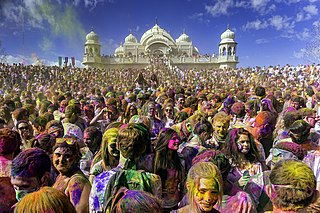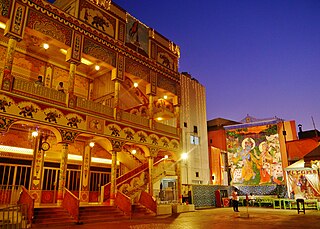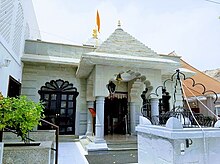
The United Arab Emirates (UAE), or simply the Emirates, is a country in West Asia, in the Middle East. Located at the eastern end of the Arabian Peninsula, it shares borders with Oman and Saudi Arabia; as well as maritime borders in the Persian Gulf with Qatar and Iran. The United Arab Emirates is an elective monarchy formed from a federation of seven emirates. As of 2023, the UAE has an estimated population of 9.97 million. Emirati citizens are estimated to form 11.6% of the population; the remaining residents are expatriates, the majority of whom are South Asian. Islam is the official religion and Arabic is the official language. Abu Dhabi is the country's capital, while Dubai, the most populous city, is an international hub.

The flag of the United Arab Emirates contains the Pan-Arab colors red, green, white, and black. It was designed in 1971 by Abdullah Mohammed Al Maainah, who was 19 years old at that time, and was adopted on 2 December 1971 after winning a nationwide flag design contest. The main theme of the flag's four colors is the sovereignty and unity of the Arab states.

Sheikh Zayed bin Khalifa Al Nahyan, also known as Zayed the Great or Zayed the First was the Sheikh of Abu Dhabi from 1855 to his death in 1909. He was the grandfather and namesake of Sheikh Zayed bin Sultan, founder of the United Arab Emirates.

Hindus are the third largest Religious group in the United Arab Emirates and constitute around 6.6%-15% of the population in the nation. Hinduism is followed mainly by the significant Nepali and Indian population in the United Arab Emirates.

Hinduism was introduced to Yemen by immigrant Indian and Nepalese workers. Hinduism in Yemen largely goes under the radar, and is only practiced by small congregations scattered around the country. An estimated 150,000 Hindus resided in Yemen in 2010. That number increased to 202,700 in 2020.

Hinduism is the fourth-largest religion in the United States, comprising 1% of the population, the same as Buddhism and Islam. The majority of American Hindus are immigrants, mainly from India, Nepal, Sri Lanka, and Bangladesh, with a minority from Bhutan, Pakistan, Afghanistan and other countries.

The earliest evidence of Hinduism in Tanzania is from the 1st millennium AD when there was trade between East Africa and Indian subcontinent. Most of these traders came from Gujarat, Deccan and the Chola empire. Archaeological evidence of small Hindu settlements have been found in Zanzibar and parts of Swahili coast, Zimbabwe and Madagascar.
The history of the Jews in the United Arab Emirates describes the historical and modern presence of Jews over the millennia in the Middle East and the recorded meetings with Jewish communities in areas that are today in the geographic territories of the United Arab Emirates.
The Dubai Hindu Temple is a place of worship for Hindus in Dubai, United Arab Emirates (UAE). The temple caters to the large Hindu community in the United Arab Emirates. The temple complex, initially established in 1958 in Bur Dubai, comprised the Shiva Mandir, Krishna Mandir, and Gurudwara.
Indians in the United Arab Emirates constitute the largest part of the population of the country. Over 3,860,000 Indian expats are estimated to be living in the UAE, which is over 38 percent of the total population of the UAE and the fourth highest number of overseas Indian people in the world, after the United States, Saudi Arabia and Nepal. Indian contact with the emirates that now constitute the UAE dates back several centuries, as a result of trade and commerce between the emirates and India. The UAE has experienced a tremendous increase in the population of resident Indians who initially migrated to the country as a result of opportunities in petroleum. Now, Indians are key to the UAE's construction, retail, financial services, healthcare, manufacturing and transport sectors. A sizeable minority of Indian migrants are involved in professional services and entrepreneurship. Relations between India and the UAE have traditionally been very friendly.

According to the 2005 census, Christians accounted for 9 percent of the total population of the United Arab Emirates; estimates in 2010 suggested a figure of 12.6%.

India–United Arab Emirates relations are the bilateral relations that exist between the Republic of India and the United Arab Emirates. Since 3000 B.C., India and the UAE, including its precursor emirates, had close relations with ancient trade networks. Sumerians traded with Meluhha, Magan, and Dilmun (Bahrain), connecting through the UAE. Maritime routes facilitated Arab trade with India for silk, spices, gold, and porcelain. Sumerians traded with Meluhha, Magan, and Dilmun (Bahrain), connecting through the UAE. Maritime routes facilitated Arab trade with India for silk, spices, gold, and porcelain. Post-1971, India-UAE relations strengthened politically, economically, and culturally.
Islam is the majority and official religion in the United Arab Emirates, professed by approximately 76% of the population.The Al Nahyan and Al Maktoum ruling families adhere to Sunni Islam of Maliki school of jurisprudence. Many followers Hanbali school of Sunni Islam are found in Sharjah, Umm al-Quwain, Ras al-Khaimah and Ajman. Their followers include the Al Qasimi ruling family. Other religions represented in the country including Christianity, Hinduism, Buddhism, Zoroastrians, Druze, Baha'i, Judaism, and Sikhism are practiced by non-nationals.

The community of Indians in Oman includes Indian expatriates in Oman, as well as Omani citizens of Indian origin or descent.

The BAPS Hindu Mandir Abu Dhabi in the UAE, is a traditional Hindu mandir built by the BAPS Swaminarayan Sanstha. Inspired by Pramukh Swami Maharaj (1921–2016) and consecrated by Mahant Swami Maharaj on 14 February 2024, this is the first traditional Hindu mandir in Abu Dhabi.

Motishwar Mandir is a Shiva temple complex located near the Al Alam Palace in the Muttrah area of Old Muscat, Oman. It is one of the oldest Hindu temples in the Middle East region. The temple celebrates numerous Hindu festivals such as Vasant Panchmi, Ramnavmi, Hanuman Jayanti, Shravan and Ganesh Chaturthi. Over 20,000 Hindus visit the temple during Maha Shivaratri.

Shrinathji Temple is a heritage Hindu temple in Manama established in the year 1817. The temple is dedicated to Lord Shrinathji, a form of Krishna, manifested as a seven-year-old child. The temple is located in the Bahrain's capital city of Manama.
Hinduism is the second-largest religion in Oman, practised by 5.5% of its population.

The Church of Jesus Christ of Latter-day Saints in the United Arab Emirates refers to the Church of Jesus Christ of Latter-day Saints and its members in the United Arab Emirates (UAE). The church's first self-standing meetinghouse in the Middle East was dedicated in Abu Dhabi in 2013. As of 2021, there are four meetinghouses and six congregations. In April 2020, the intent to construct a temple in Dubai was announced.
Events in the year 2024 in the United Arab Emirates.














